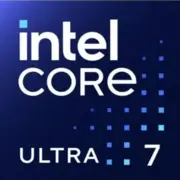Intel Core Ultra 7 155H

Intel Core Ultra 7 155H: Hybrid Power for Versatile Tasks
Overview of the Meteor Lake processor for laptops in 2025
Architecture and Process Technology: A New Era of Hybrid Computing
The Intel Core Ultra 7 155H is the flagship model in the Meteor Lake lineup, built on a 7nm process. Its architecture combines 16 cores (6 Performance-cores, 8 Efficiency-cores, and 2 Low Power Efficiency-cores) and 22 threads, allowing flexible task distribution.
CPU Features
- P-cores (Performance): Operate at a base frequency of 3.8 GHz with turbo mode up to 4.8 GHz, optimized for demanding tasks such as rendering, gaming, and 4K editing.
- E-cores (Efficiency): Energy-efficient cores for background processes (browser loads, streaming).
- LP E-cores: A new type of core for ultra-low power consumption in idle mode.
- L3 Cache: 24MB - reduces memory access latency.
Integrated Graphics Xe LPG 128EU
The iGPU with 128 Execution Units supports DirectX 12 Ultimate and AV1 decoding. In games at Full HD (e.g., CS2 or Fortnite), it achieves 40-60 FPS at medium settings. For creative tasks (Premiere Pro, DaVinci Resolve), it accelerates rendering by 15-20% compared to the previous generation Iris Xe.
Power Consumption and TDP: Balancing Power and Battery Life
The nominal TDP of the processor is 28W, but in turbo mode, consumption can rise to 64W (briefly). This allows laptops to maintain a slim profile without overheating.
Energy Optimization Technologies
- Intel Thread Director: Dynamically distributes tasks among cores, reducing the load on P-cores.
- Adaptix Voltage Scaling: Automatically lowers core voltage during idle states.
- Eco Mode: Limits frequencies to 2.5 GHz, reducing power consumption by 30%.
Performance: Tests in Real-World Scenarios
Office Work and Multimedia
- Chrome with 50 tabs + Zoom: RAM consumption up to 12GB, CPU load 25-40%.
- 4K Video Editing in Premiere Pro: Rendering a 10-minute video takes 8-9 minutes (compared to 12 minutes with the Core i7-13700H).
Gaming
- In games with a discrete GPU (e.g., RTX 4060), the processor does not become a bottleneck: Cyberpunk 2077 (Ultra, DLSS) yields 75-90 FPS.
- On iGPU in GTA V (Medium, 1080p) — stable 55-60 FPS.
Turbo Mode: How Long Can It Hold Up?
Under load (e.g., rendering in Blender), the processor maintains frequencies of 4.5-4.7 GHz for 3-4 minutes, then reduces to 4.2 GHz to prevent overheating. In laptops with enhanced cooling (e.g., MSI Stealth 16), this period extends to 6-7 minutes.
Use Cases: Who is the Ultra 7 155H Suitable For?
1. Creative Professionals: Videographers, 3D designers will appreciate the rendering speed.
2. Gamers: Paired with a discrete GPU (RTX 4070 and above) — smooth FPS in AAA titles.
3. Students and Office Users: Multitasking without lag.
Examples of Laptops:
- Dell XPS 15 (2025): Price starting at $1,800, weight 1.8 kg, 4K OLED display.
- ASUS ZenBook Pro 14: Price $1,600, compact case with RTX 4050.
Battery Life: How Long Will It Last?
With a TDP of 28W, battery life may vary:
- Web surfing (150 nits): Up to 10 hours.
- Video playback (local 4K): 6-7 hours.
- Gaming on iGPU: 2-2.5 hours.
Tip: Choose laptops with a battery of at least 75 Wh (e.g., Lenovo Yoga Slim 9i) for maximum battery life.
Comparison with Competitors
AMD Ryzen 7 8840HS
- Pros: Better energy efficiency (up to 12 hours for office tasks).
- Cons: Weaker in single-threaded tasks (Geekbench 6 Single — 2287).
Apple M3 Pro
- Pros: Battery life up to 18 hours, optimized for macOS.
- Cons: Limited compatibility with Windows applications.
Price Segment: Laptops with Ultra 7 155H are cheaper than those with M3 Pro ($1,500 vs $2,000).
Pros and Cons of the Processor
Strengths:
- High multi-threaded performance.
- Support for Thunderbolt 5 (up to 120 Gbps).
- Modern iGPU for light gaming.
Weaknesses:
- Heating in thin cases (e.g., HP Spectre x360) under load.
- Higher price than Ryzen 7 8840HS.
Recommendations for Choosing a Laptop
1. Ultrabooks (Acer Swift, LG Gram): Focus on weight (up to 1.3 kg) and battery life.
2. Gaming Models (Razer Blade 16): Ensure the presence of a discrete GPU and cooling systems with 3+ heat pipes.
3. Workstations (MSI Creator Z17): 32+ GB RAM, 1 TB SSD, display with 100% DCI-P3 coverage.
What to Look For:
- Cooling: Two fans are better than one.
- Battery: Minimum 70 Wh.
- Ports: Thunderbolt 5 for connecting external 8K monitors.
Final Conclusion: Who is This Processor For?
The Intel Core Ultra 7 155H is the ideal choice for those seeking a balance between mobility and power. It is suitable for:
- Freelancers working in the field with demanding software.
- Gamers who do not want to carry a 3 kg laptop but want to play at medium settings.
- Students balancing their studies, streaming, and light gaming.
Key Benefits: The hybrid architecture saves battery charge, while high performance eliminates the need to buy a desktop. In 2025, laptops powered by this processor range from $1,300 (budget models) to $2,500 (premium segment), making them accessible to a broad audience.
Basic
CPU Specifications
Memory Specifications
GPU Specifications
Benchmarks
Compared to Other CPU
Related CPU Comparisons
Share in social media
Or Link To Us
<a href="https://cputronic.com/cpu/intel-core-ultra-7-155h" target="_blank">Intel Core Ultra 7 155H</a>





